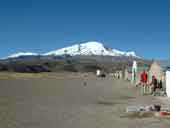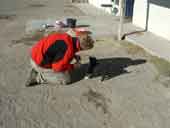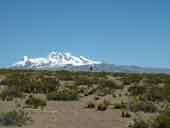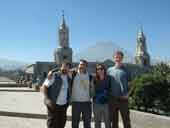Our outfitter, Saul Ceron, woke us early this morning with news of an impending strike by Arequipa’s taxi drivers and certain gridlock in the city today. So we left for Coropuna somewhat in a hurry and were crossing the desert outside Arequipa by breakfast time. The drive to Coropuna is long – eight hours or so – and in places very rough. The road descends into the second-deepest canyon in the world, the Majes, and then rises up in a long series of unpaved switchbacks to the plateau edge at 4300 m above sea level. En route is a park dedicated to the local discovery of fossilised dinosaur bones and footprints and so, braving swarms of biting flies, we stopped to tour this attraction which features life-sized models of a Diplodocus and a Megalosaurus. Once on the plateau, the glaciated mass of Coropuna, turning pink in the sunset, dominates the horizon to the northeast. Another three hours of extremely bumpy driving brought us to the small herding station of Mauca Llacta, our home for the night and starting point for the walk in to Coropuna.
After three days of soft beds, fine cuisine, and leisurely living in Arequipa, Mauca Llacta is a wake-up call to what life in Peru is really like. The houses are single storey, constructed from adobe or concrete, with no electricity or water (water is collected from a small stream). The diet of the station’s inhabitants is meagre - alpaca meat, potatoes, and occasional fruit brought up from the canyons below – and, consequently, the people of Mauca Llacta are relatively small and thin, yet they are still some of the most industrious and helpful people I’ve met anywhere. Señor Ermitanio HH, our mule driver from last year, lives here and we hope to find him tomorrow to arrange some mules (called ‘burros’) for our work this year. Tonight, however, we are staying in a small concrete barn behind the town’s medical centre. It is dusty and really cold in here but serves to keep the wind and prowling dogs at bay.




